5/15
Xi'an
I got an early start, and got up to the Terracotta Warriors site before the ticket office opened. Time enough to write up the morning.

0613. Circle bridge on Jiefang.

0614. Up to the station.

0615. Elephants, coming down.

0616. Pagoda on the way out.

0617. Up to the mountain.
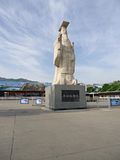
0618. Statue coming in from the parking lot.

0619. Mountains over the bag drop.
It's probably faster by cab, but 8 yuan is fair cheap for an authentic experience, even riding with regular commuters for most of it. Let China be cheap where it can, save your cash for where it isn't.

0620. Not "bite the wax tadpole", but most of "can mouth can happy".

0621. Mountains, inside.

0622. Trees in the entry garden.

0623. Plaza before the Pit 2 hall.

0624. Path and trees.
0625. (DNCO)..

0626. Recovered stoneware.

0627. Iron tools of the builders.

0628. Scratched inscriptions.

0629. Pottery from the site.

0630. Halberd and mostly-decayed shaft.

0631. Kneeling archer.

0632. Bronze crane.

0633. Slate mail; not very practical, but if you're building your afterlife army in terracotta rather than from sacrifices, it's ok to make armor that just looks good for your grave goods.

0634. Stable pit reconstruction. Most of the horses in the pits are terracotta, but several have been recovered from the stable areas that were buried alive, standing up.

0635. Roof tile; note the pinyin. This must not be on the list of characters required for graduation-level literacy.

0636. Stone d14.

0637. Imperial edict on a weight.

0638. Grave in bronze.

0639. Chariot I.

0640. Closer detail.

0641. Front of Chariot II.

0642. Driver detail.

0643. Better light on the car.

0644. Industrial process; yours is an engineer to the last.

0645. Reproductions for joint detail; these belts are all metal, made with the processes that were available to the artisans who built the bronze chariots.

0646. Gold and silver bridle (reproduction).

0647. Spare parts. These go on Chariot I somewhere, but there's no clear indication of where, and the instruction sheets are of course missing.

0648. Towels and canteens.

0649. Party mission statement.

0650. Not the torch, but the one that came through here on the way to Beijing.

0651. Pan across Pit 2.

0652. Rubble to sift; this is an active dig.

0653. Horses as well as men.

0654. Dug out as they lay.

0655. Scrapings in the earth.

0656. Tarp to protect an exposed area.

0657. A squad mostly together.

0658. Another take.

0659. More pieces.

0660. View across the excavations.
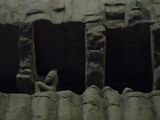
0661. One in a trench.

0662. Shattered soldiery.

0663. Small cell and a few statues.

0664. Team of horses.
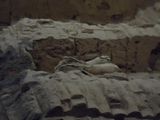
0665. A better take, probably.

0666. Original burial pit walls.

,br /> 0667. Standing archer.
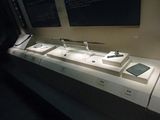
0668. Weapons of the buried.

0669. Cavalryman and charger.

0670. "Captain" figure.

0671. One of seven (not 13) generals found so far.

0672. Texture of the roof.

0673. Men and horses lie together.

0674. More in a wider pit.

0675. More cavalry.
0676. (DNCO).

0677. Recovered horse bones.

0678. Non-bony horses.

0679. Retaining wall of the chamber.

0680. A dark chariot wheel.

0681. Trees outside Pit 3.

0682. More of the park.

0683. Into Pit 3.

0684. Decimated ranks.

0685. Side view on the front team.

0686. Silent guards.

0687. More as scrap.

0688. The first view into Pit 1.

0689. Closer down.

0690. To the right.

0691. To the left.

0692. Dressing along the rank.

0693. Along the hall.
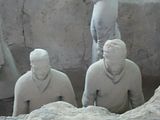
0694. Close on two.

0695. One squad of hundreds if not thousands.

0696. Cav's here too.

0697. Escaping the clay.

0698. Ranks of standing soldiers still.

0699. Strewn and tossed.

0700. Active dig portion. There were "no photo" signs further down, but the point of these was to protect the privacy of the OLs working at the incongruous office desks plunked in the middle of the site, who would otherwise be creeped on by thousands of tourists while they're just trying to do their jobs.

0701. Excavation conservation.

0702. Waiting block.

0703. Ranks of the restored.

0704. Tagged to position.

0705. Assembly area.

0706. The world's biggest jigsaw puzzle.

0707. How reconstruction starts.
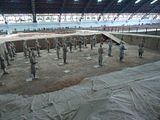
0708. Setting for now.

0709. Finished and fallow; about 40% of Pit 1 so far is fully assembled, and 30-40% of the site is not even excavated yet.

0710. Attention front.

0711. Close up on the first ranks.

0712. Further back in file.

0713. Up into the hangar structure; a barn for two Bears was probably the biggest-footprint building the Chinese government could put up on short notice in 1975, so that's what they built, and have improved on since.

0714. Mountains over a store corner; the museum does a good job keeping the vendors in the vendor area, but you shouldn't bother going in the museum store unless you know nothing about China at all and are not overly attached to the contents of your wallet. The souvenir sets in here start at 500 yuan, marked as a solid price; I was offered them at 30 by a tout who'd gotten into Pit 1, and when I actually did souvenirs, I got the next tier up (1000元 in the store) at a tenth of the price, with extensive vendor service, and felt I did a bad job of haggling it.

0715. Garden heading to the vendor area.

0716. Horses bound up a fountain.

0717. "Biang" with construction guide. There are like 12 sub-character radicals in this thing, which is too niche and nonstandard to have a simplification or a Unicode point, but you don't need to know how to write it; just find it and ask for "biang biang mian", and you'll get a bowl of wide flat noodles with (usually) a spicy meat sauce. This was today's awesome $3 lunch; make it yours and don't go to the fucking Subway.
I did ok on souvenirs, though my haggling on the first part could've been better. Regardless, I'm short just Chengdu and HK stuff, which is a good position to be in when that's about all's left of the trip.
I have a ton of time before the train, so I'd rather kill it outside; I'll finish these Landmarks (蓝马, so there's a blue horse on the bottle), cram in some Lanzhoumian, and then submit to the push and stand. At least it's a lower bunk this time.

0718. Blue sky beyond the clouds. I think this is the first since Qingdao.

0719. Close on the station front.

0720. A probably origin of the "English muffin". Unknown in England, but common here in Central Asia, these buns are cooked between two grills to a limited height, then fork- or chopstick-split and filled. Irish or Scots soldiers sent to India would have had first contact with them from Afghan or Pakistani vendors, filled them with ration condiments (instead of the incredibly aggressive spicy-vegetable mix in this one), and put a meal dusting on when making them at home.
I don't actually know where the train is yet (too early), but there's space in hall 1, and I can check again in a few hours.
Xi'an has more pictures than any other city to date, the fruit of two days' hard touring a lot of scenic sites. I had more time in Harbin, and about as much in Shanghai and Qingdao, but here I was ready, and there was all to see. If you go to China, warm up on the coast by all means; land in Shanghai, take a jetlag adjustment day, do the first-timer menu while you're getting your feet under you, do Beijing and Badaling by 高铁 as you get a grasp on the country, and then go to Xi'an when you're ready to go the furthest and hardest. Tonight's train will suck, because Chinese hard sleepers inherently suck, but tomorrow in Chengdu is the end of the middle leg and, really, the start of the end, though for my part the trip isn't "ending" while I still have an army pack to muscle around.
Reflecting on Xi'an, it's really remarkable the condition it's been able to remain in; how green, how well-preserved. The city's remote location, cheap land outside the walls, and revolutionary importance preserved it, probably, until the terracotta warriors were discovered -- at which point preserving rather than developing Xi'an became a matter of national importance.
This is because above and beyond the tourism revenues from across China and around the world, Bingmayong allows China to tell themselves the kind of story they most desire to tell of themselves. The immense antiquity, the idea of an ultimate power sleeping away in the earth, industrial sophistication, the wealth to carry it off -- it's important for China today to believe in these as eternal marks of China, past present and future. The ability to tell that story well, and in a consonant setting, is worth hundreds of ring roads where the wall stands, thousands of apartment buildings inside it rebuilt to 30 floors rather than five. China comes apart when agriculture can't keep up with the population, but it will come apart faster and harder if people cannot have an idea to lead them, coughing through the coal smoke, dodging a motortrike, through planks on a construction site at their doorstep, into a future worthy of the glorious past.
Train's still not posted. Another hour or so, probably.
Finally got to the right hall; about an hour and a half till lineup.
Most Chinese people have specialized luggage now, of course, but in rural sub-高铁 halls like this, you still see the old ways: a 20-kilo rice sack, or a couple 5-gallon buckets. The buckets are more generally useful -- they have handles, and you can sit on them if the hall's packed -- but you can't fit nearly as much stuff in them, or generate them passim via a month's cooking. Horses for courses, probably; a short trip can be done in a bucket, but a migrant laborer coming home will have all his rice bags to bale up all his stuff.
Not only is the bunk big enough to sit up in, with an easy stow for all my kit, the company is a lot better: younger, mixed, closer to Putonggua, and in the next compartment a bunch of Germans under guide. It's almost too bad that this is the short leg, but it's still a hard sleeper with hole-in-the-floor facilities.
The heat in the train let me know I'd lost my handkerchief at some point; I wasn't really using it, since for sweat or dust my hat's usually more to hand, so all this means is I need to get another at some point when I get back.
v34. From a lower berth. Lights-out is enforced by the provodniks around 10 pm.
No comments:
Post a Comment